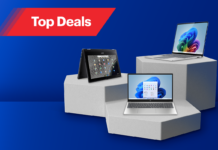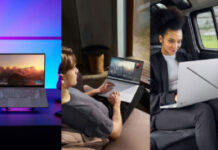![]()
If a Chromebook is what you have in mind for a laptop, the Pixelbook Go is one of the best you can lay your hands on—so long as you’re okay with the quirks.
Google put some luxury into each Chromebook going back to the Pixelbook two years ago. Last year’s Pixel Slate was more a tablet that functioned like a Chromebook because of the keyboard. The Pixelbook Go is almost a cross between them, more laptop than anything else.
This isn’t meant to be a toy, as Google believes it has plenty of upside on productivity. That depends on your point of view, though. Chrome OS is still an evolving platform, so your workflow is a big factor. I took it for rigid testing to find out if it can make that case.
Google Pixelbook Go
|
Design
There are two key things to immediately note about the design. First, the Pixelbook Go doesn’t bend over backward 360-degrees like the first Pixelbook does. Second, it sports a 16:9 aspect ratio compared to the previous model’s 3:2 aspect ratio.
That’s not all, mind you, but those were the first two things I noticed when Google unveiled it. Once I had it in my hands, I found a number of other contrasting points. The 13.3-inch display has a 1080p HD resolution (there is a 4K variant) with smaller bezels around it. It remains a flush screen, so easy to clean and maintain, among other things.
It sports a neutral all-black design with no glass on the top or bottom. (NOTE: the Pixelbook Go is also available in a pinkish colour that Google calls “Not Pink”!)The rippled bottom surprisingly feels smooth and almost rubbery, even though there’s nothing rubbery under there. The hinge is excellent, offering a nice, steady hold on the top, yet feels easy to pry open with one hand when it’s closed.
Under the hood, you can choose from three configurations. The specs for my test unit are listed to the right, but it’s basically the best you can get, except for the 4K model. To be honest, 4K resolution is a bit much for any Chromebook, so I find the one I tested to be the most balanced option.
The Pixelbook Go also mirrors the Pixelbook in that it has two USB-C ports and a headphone jack. Another interesting addition is the 1080p HD camera, which isn’t a common spec for laptops, though it’s limited to just 2-megapixels.
But without question, the keyboard makes this device what it is. The first Pixelbook is still one of my favourites to type on, and Google wisely chose to include its “Hush” keyboard here.
![]()
The keyboard and trackpad
The Pixelbook Pen is compatible with the previous Pixelbook and the Pixel Slate, but it won’t work here. Instead, this device is every bit a laptop, despite the touchscreen support. My tendency with the Pixelbook was to touch the screen more than use the trackpad.
With the Pixelbook Go, I did the reverse, where I would often defer to the trackpad to navigate the interface. Not that the trackpad is exceptional; it’s adequate, and better than some other Chromebooks I’ve tried, but that’s also something I would expect from a premium laptop.
It’s the keyboard that truly stands out, and if like me, you type a lot on any given day, the keys on this thing will feel almost perfect. They are backlit and feature just enough travel time with each stroke to be both quiet and accurate all at once. It’s a superb design and one that would be even better if there was a lot to do with it.
![]()
Pixelbook Go and Chrome OS
Chrome OS is neither MacOS nor Windows, but when a Chromebook is in the same price range, there needs to be a payoff. Naturally, Google’s apps and services are not far away, from the Chrome browser and on to Google’s own office suite. As always, several apps you’re accustomed to in Android are here too. Click on them and they open in a browser, like Google Maps does.
On paper, the experience may sound more cumbersome than it really is. The thing about Chrome OS is that it’s always a work in progress. Many key third-party apps are there, including Microsoft’s Office suite and Adobe Lightroom, among others, but it goes beyond that. Apple and Microsoft have file systems, drivers and other digital nuts and bolts that tie things together, be it for software or hardware peripherals. Chrome OS feels lighter by default, but that comes with those trade-offs.
Then there are all the Android apps available. The Google Play Store offers countless apps, even if all of them aren’t optimized for a laptop screen. Google Assistant is always readily available, and Stadia, the company’s streaming gaming platform, is set to go for that launch as well.
On the bright side, Chrome OS accords itself better in a laptop than it does with the Pixel Slate’s tablet. That’s why the touchscreen makes sense here. Using certain apps requires touching the screen to feel convenient and efficient.
![]()
Performance
I typed this review on the Pixelbook Go, but it’s not the only one I worked on lately. A keyboard this good makes it easy when you have to write something every day. It’s the rest of the laptop that I found had its own quirks.
The speakers lining the sides of the keyboard are sufficiently loud, even if they aren’t heavy on bass. Google also fixed the Bluetooth issues that hampered the first Pixelbook. I had no problems pairing with speakers or headphones. YouTube would sometimes fail to play sound via Bluetooth, but only if the app had been on standby for longer periods.
Productivity depends on your choice in services. I mentioned earlier that Google’s services are easy to find, and they are. Anything browser-based will work fine here, so whether it’s WordPress, Google Docs, Gmail, Slack, Trello or some other work-related tool, you should be fine. It’s the standalone apps that will be more hit or miss based on optimization.
On the consumption side, watching video is great. I routinely used the Pixelbook Go to watch YouTube, or live sports on NHL, DAZN, and NBA League Pass. Netflix, Prime Video, and Crave were great as well. I listened to streaming music on various platforms too. You shouldn’t run into any problems doing any of that on this device.
The question is whether this is the laptop to do it on. You can do all of that on a Mac or Windows laptop—for a similar or lower price. However, one thing about a Chromebook at this level is that it stays consistent throughout. My Pixelbook still runs much like it did when I got it. I would expect the same thing of the Pixelbook Go two years from now.
Battery life
The Pixelbook Go also has some of the best battery life I’ve seen in a 13.3-inch laptop. Google rates it at 12 hours per charge, but I actually did better than that. When I used it lightly, I cracked 13 hours. With a lot of video streaming, I went past 10 hours every time. The only instance where it lasted for less was if I was mirroring the screen to the TV via Chromecast.
If you plug in for a 20-minute charge, you can get two hours out of it. I tried it, and it’s true. The quick-charge function works as advertised, and I appreciated that I didn’t have to charge this unit as much as the previous two.
Final thoughts
If you have a Pixelbook or Pixel Slate already, there’s no reason to upgrade to this model. The similarities, especially to the Pixelbook, are evident. Besides, that device had the literal flexibility to be more than just a traditional laptop.
If you haven’t tried a Chromebook before, the Pixelbook Go may be a good place to start. However, it’s with the caveat that you prefer a laptop form factor and don’t care for the lack of pen support. I would certainly advise playing around with one if you see it on display in-store.
The Google Pixelbook Go is available now in two configurations: the Core m3 and Core i5, and two colours: “Just Black” and “Not Pink“.




Love how fast the pixelbook charges !! As a busy mom being forgetful happens but this charging speed is amazing
Comments are closed.